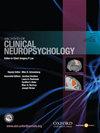A - 54 Changes in the Blink Reflex after a Sport-Related Concussion: Test–Retest Reliability of a Blink Reflexometer
IF 2.1
4区 心理学
Q2 PSYCHOLOGY
引用次数: 0
Abstract
The blink reflex may be affected by concussion, but psychometric analyses examining devices that measure the blink reflex are limited. This study assessed the test–retest reliability of the Blinkcns EyeStatTM device at two pre-season baseline time points in a cohort of healthy high school athletes. During pre-season, high school athletes completed the EyeStatTM scanning twice, 15-minutes apart. Pearson/Spearman correlations and Intraclass Correlation Coefficients (ICC, i.e., the measure of test re-test reliability) were calculated across 10 different parameters (e.g., latency, total blink time, oscillations, time to open/close). Additionally, t-tests examined if these parameters differed based on biological sex, sleep status (i.e., <8 vs. ≥8 hours the night before), and prior concussion history (i.e., 0 vs. ≥1 prior concussions). Of the 48 athletes (age, M = 16.0¬ ± 1.2 years), 35.4% were female. Correlations ranged from 0.45–0.82 (all p-values<0.001) between the two assessments, and ICCs were 0.46–0.87 (all p-values<0.02). Additionally, none of the Eyestat parameters were significantly associated with biological sex, sleep status, or prior concussion history (all p-values>0.05). This study suggests substantial test–retest reliability of the EyeStatTM device across 10 parameters in a cohort of healthy high school athletes. The findings support the potential utility of the EyeStatTM device as a reliable baseline measure for assessing the blink reflex among young athletes.A - 54 运动性脑震荡后眨眼反射的变化:眨眼反射仪的测试-重测可靠性
眨眼反射可能会受到脑震荡的影响,但对测量眨眼反射的设备进行的心理测量分析却很有限。本研究评估了 Blinkcns EyeStatTM 设备在季前两个基线时间点对健康高中运动员群体的测试-重复可靠性。 在季前赛期间,高中运动员完成了两次 EyeStatTM 扫描,每次间隔 15 分钟。计算了 10 个不同参数(如潜伏期、总眨眼时间、振荡、睁眼/闭眼时间)的皮尔逊/斯皮尔曼相关性和类内相关系数(ICC,即测试再测试可靠性的衡量标准)。此外,还对这些参数是否因生理性别和睡眠状态而异进行了 t 检验(即 0.05)。 这项研究表明,EyeStatTM 设备在健康高中运动员群体中的 10 项参数的测试-再测试可靠性非常高。研究结果支持 EyeStatTM 设备作为评估年轻运动员眨眼反射的可靠基线测量方法的潜在用途。
本文章由计算机程序翻译,如有差异,请以英文原文为准。
求助全文
约1分钟内获得全文
求助全文
来源期刊
CiteScore
4.60
自引率
7.70%
发文量
358
审稿时长
6-12 weeks
期刊介绍:
The journal publishes original contributions dealing with psychological aspects of the etiology, diagnosis, and treatment of disorders arising out of dysfunction of the central nervous system. Archives of Clinical Neuropsychology will also consider manuscripts involving the established principles of the profession of neuropsychology: (a) delivery and evaluation of services, (b) ethical and legal issues, and (c) approaches to education and training. Preference will be given to empirical reports and key reviews. Brief research reports, case studies, and commentaries on published articles (not exceeding two printed pages) will also be considered. At the discretion of the editor, rebuttals to commentaries may be invited. Occasional papers of a theoretical nature will be considered.

 求助内容:
求助内容: 应助结果提醒方式:
应助结果提醒方式:


